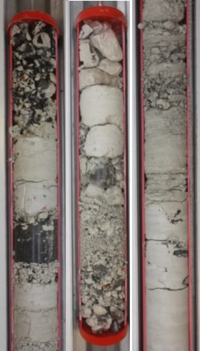Difference between revisions of "Physical processes and governing equations"
m (→Properties of limestone) |
m (→Properties of limestone) |
||
| Line 22: | Line 22: | ||
== Properties of limestone == | == Properties of limestone == | ||
[[File:BoreholeCores.png|thumbnail|200px|Borehole cores from the Akacievej field site.]] | [[File:BoreholeCores.png|thumbnail|200px|Borehole cores from the Akacievej field site.]] | ||
| − | Low conductive matrix - can be heavily fractured - chert layers and nodules - sorption behavior for chlorinated solvents | + | Low conductive matrix - can be heavily fractured - chert layers and nodules - varying hardness - sorption behavior for chlorinated solvents |
Return to [[Content]] | Return to [[Content]] | ||
Revision as of 09:24, 16 September 2016
Contents
Physical processes
Advection, diffusion and dispersion, fracture flow, sorption and retardation
Governing equations
Flow
Groundwater flow in porous media is usually described by Darcy's law, giving a relation between hydraulic head gradient and groundwater flow. The fracture conductivity is usually determined via the fracture aperture using the cubic law.
Darcy's law.
Cubic law.
Flow equation.
Contaminant transport
To describe the transport of a substance in a porous medium, the advection-dispersion equation is usually employed. It includes the storage, advective and dispersive transport of a substance. Retardation due to sorption and degradation can be included.
Properties of limestone
Low conductive matrix - can be heavily fractured - chert layers and nodules - varying hardness - sorption behavior for chlorinated solvents
Return to Content
